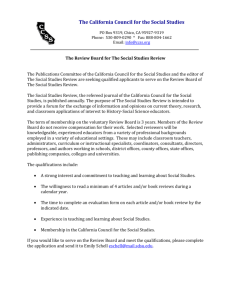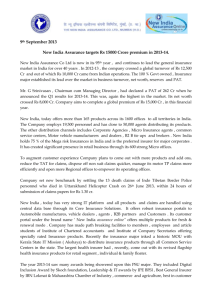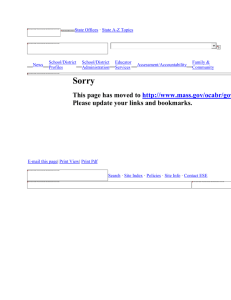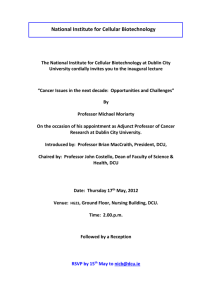Template for Self-Assessment Report
advertisement
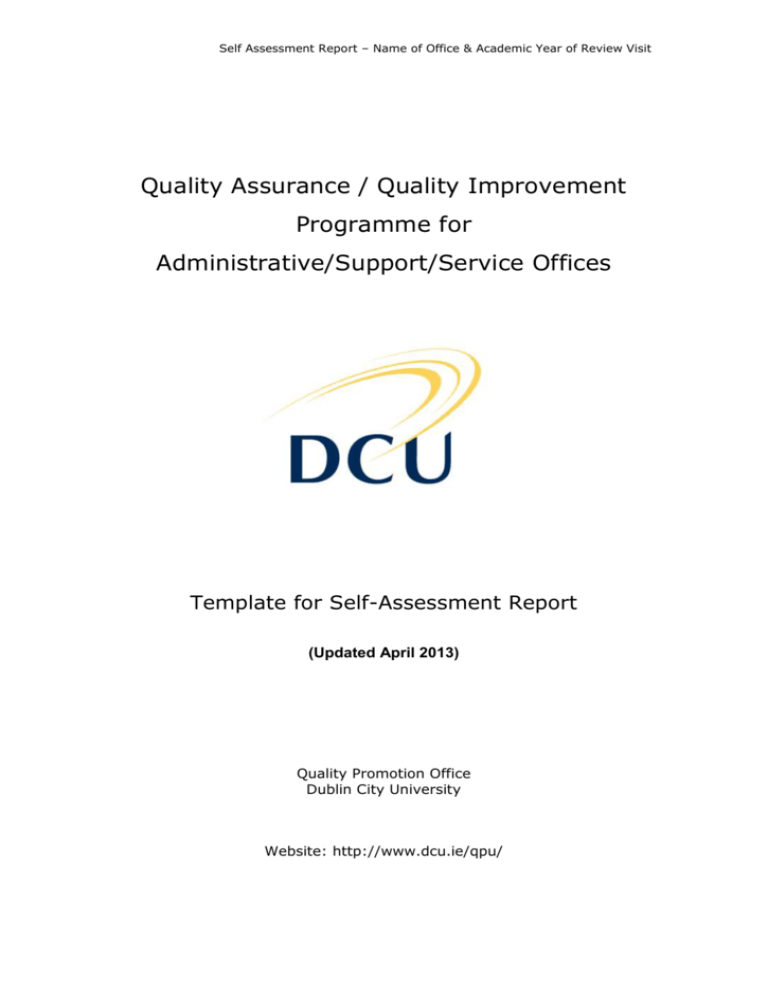
Self Assessment Report – Name of Office & Academic Year of Review Visit Quality Assurance / Quality Improvement Programme for Administrative/Support/Service Offices Template for Self-Assessment Report (Updated April 2013) Quality Promotion Office Dublin City University Website: http://www.dcu.ie/qpu/ Self Assessment Report – Name of Office & Academic Year of Review Visit QUALITY REVIEW PROCESS Regular reviews of all University activities are essential to the University’s strategic objectives. In addition, the Universities Act (1997) obliges the governing authorities of all universities to arrange for the evaluation of all academic areas and service/support offices on a regular basis. For every (a) (b) (c) area to be reviewed, the process consists of three stages: Self Assessment Review by an expert group and feedback from participants Follow-up activities The procedures for internal quality reviews are revised each year in the light of feedback from participants. The 2012 edition of the document ‘Quality Assurance/Quality Improvement – Background and Guidelines for the Quality Review Process’ is available on the QPU website at http://www.dcu.ie/~qpu. The deadline for submission of self-assessment reports and accompanying appendices (18 bound, hard copies of each) is four weeks before the visit of the Peer Review Group. As a guideline, Self Assessment Reports should not exceed a maximum of 30 pages, excluding: Executive Summary, Self Assessment Reports of offices reporting to the main office and Appendices. The Self Assessment Report (SAR) template presented here is intended to facilitate compilation of the self-assessment aspect of the quality review. Under each section heading, a series of questions are included that the Office might take into consideration in preparing the SAR. Some of these questions however may not be relevant to the tasks performed within individual Offices. The Office should therefore also consider any relevant issues or questions that are not covered by those provided. The development and writing of the SAR is a self-reflective exercise, not just a statement of facts and information about the Office. This is particularly important in regard to providing the results of, and analysis/reporting on the quantitative surveys and quality research (focus groups, interviews, away days). The summary views and opinions of Office Staff, DCU Staff and DCU students (if relevant to the office) are important to include in the text of the SAR, and full survey and other research information should be provided in the appendices. It is also important to include the Office’s analysis of these views, and how it expects to act on them in the future. The SWOC section of the SAR can be provided as a table listing Strengths, Weaknesses, Opportunities and Concerns/Challenges. Further self-reflection discussion should be provided along with the table so that the PRG have some knowledge of how the Office plans to take into account the findings from four aspects of the SWOC in regard to planned future developments. During the Peer Review Group (PRG) visit, the PRG members are free to request additional information from the Office including, but not limited to, management reports, minutes of meetings, financial and statistical information. Offices should have available for the Review Group, copies of relevant reports compiled in the previous five years as well as the current Office budget. The Review Group may also request interviews with individuals who have not been scheduled in the review visit timetable. Self Assessment Report – Name of Office & Academic Year of Review Visit Quality Assurance / Quality Improvement Programme for Administrative/Support/Service Offices (Insert Academic Year here) Self-Assessment Report Of (Insert Name of Office here) Date: Self Assessment Report – Name of Office & Academic Year of Review Visit Quality Assurance / Quality Improvement Programme for Administrative/Support/Service Offices 1. Executive Summary 2. Introduction 3. Office Details 4. Progress report since last Quality Review(s) 5. Planning and Organisation 6. Functions, Activities and Processes 7. Customer/User/Stakeholder Perspective 8. Staff Perspective 9. Management of Resources 10. Analysis of Strengths, Weaknesses, Opportunities, Challenges 11. Self Assessment of Offices/Services/Centres Reporting to Main Office (if relevant) Appendices In the following pages, a number of questions are provided as prompts for completion of each section in the Self Assessment Report. Guidelines stating the kind of information that should be included in each section are also provided. These questions should be removed from the final report. Self Assessment Report – Name of Office & Academic Year of Review Visit 1. EXECUTIVE SUMMARY It is important to provide a clear Executive Summary of the SelfAssessment Report. This should not be greater than 3 pages in length, and should include an overview of the Office and overall organisation structure including any offices reporting into the main office. The Executive Summary should also provide a summary of the information included in the main sections of the report, including a summary SWOC (Strengths, Weaknesses, Opportunities, Challenges) analysis. 2. INTRODUCTION Scope of Quality Review Explanation of how the Self Assessment Report was developed, and an overview of what was included. Office Quality Review Co-ordinating Committee Name, grade/title and area of each member of the co-ordinating committee, in alphabetical order, Chair first. Brief Methodology of review committee process Include, for example: Number of meetings held by the committee Allocation of tasks Degree of communication with Office staff not on the co-ordinating committee 3. OFFICE DETAILS Provide a brief description of the Office which should include the main activities of the Office, the offices that report to it, and any relevant committees under its remit. If appropriate, describe how the Office has grown, developed, or changed in recent years. This section should set the overall scene for the Review Group. Physical Facilities Include a list of rooms, and facilities etc. used by staff of the main Office and offices that report to the main Office, with occupancy details. Reflect on adequacy of provision. Top Management Structure Provide details of the top management structure of the Office Self Assessment Report – Name of Office & Academic Year of Review Visit Office Organisation Chart Provide details of the main Office organisational chart including reporting lines up to and down from other offices. Summary Details of Staff Outline, in tabular form the summary details of staff in the Office with relevant areas of responsibility indicated. This should include staff in the main Office as well as those in associated offices. Reflect on adequacy of provision. Office Staff Area (examples) Name Grade Years at Grade Years at DCU Responsibilities Office Management Office Admin Area 1 (Office reporting to main office) Area 2… Area 3… 4. PROGRESS REPORT SINCE LAST REVIEW(S) Include here an outline of the progress and/or the developments/enhancements made in the Office, and Offices reporting into the main Office where relevant. This section should include an indication of how the Office addressed the recommendations made by the Peer Review Group in any previous review(s), and reflect on how well the recommendations were able to be addressed. 5. PLANNING AND ORGANISATION This could include a description, analysis and reflection/assessment of the following items: Strategic Planning Outline the Office’s Strategic Development Plan. International good practice indicates that this should include the following: Self Assessment Report – Name of Office & Academic Year of Review Visit A carefully defined Mission Statement and a detailed description of the Office’s operations and goals in such areas as the services provided by the office, hiring, training and development, process documentation and improvement, quality measures, benchmarking etc. These goals should be consistent with the University’s institutional objectives, and should take into account the needs of the users of the service and how these needs are identified, prioritised and translated into objectives; A motivating Vision for the Office that describes a desired status, or the achievement of some major goal over the next ten years. A Physical Resource Analysis - a stocktaking of the existing resources which identifies those which are essential for the future and those which might arise in connection with various strategic options; A Human Resource Analysis - which should identify the interests and strengths of its existing staff and deficiencies that could become priorities in impending recruitment. Other questions to consider in this section include: Does the Office regularly collect data on benchmarking, the performance of the internal processes/operations, supplier performance, user-related performance, and is this data used in planning and in day-to-day operations? How does the Office plan for new services and innovations? What overall assessment/reflection can be made on strategic planning? Management Structure Describe and analyse the management structure in the Office and any other offices that report to it. How are the tasks delegated and responsibilities assigned? What are the reporting structures? Describe, analyse and reflect on the formal decision making procedures in the Office. For example: Are there regular meetings of full-time staff with agendas circulated in advance and with brief minutes of key decisions and action items? Who attends? Are staff consulted on upcoming appointments, and if so which staff are consulted? Self Assessment Report – Name of Office & Academic Year of Review Visit What overall assessment/reflection can be made on the management structure? Budgeting Describe and analyse the budgetary arrangements in the Office. information from central administration timely and accurate? Is What overall assessment/reflection can be made here? Communication How is communication assured among staff members in the Office? How are staff members kept informed of changes in procedures, and of decisions taken in other parts of the University that may affect their work? Could most staff members list the Office’s goals relevant to their activity, and are they familiar with the plans to achieve them in their areas? Are there formal procedures in place for dealing with staff concerns and differences? How is communication assured externally, with other Service Offices and users? What overall assessment/reflection can be made here? 6. FUNCTIONS, ACTIVITIES AND PROCESSES This section examines how the Office manages its processes for the delivery of its key products and/or services. The Office is encouraged to provide sub-headings for various activities where appropriate. It also examines the procedures for the control and improvement of these processes, and for documentation of the processes to confirm that they are used and are effective. Examples of questions that could be asked to address this section include: What functions, activities and processes are carried out in the Office, and how are these undertaken. Are the facilities and services appropriate and sufficient to fulfil the Office’s objectives? Is there a comprehensive system for ensuring that customer/user requirements are taken into account?, Is there a comprehensive development plan for new products and services ensuring that all new activities, key performance and supplier requirements are identified and that the outcome is validated at key phases during development? Self Assessment Report – Name of Office & Academic Year of Review Visit Does the Office have a system to ensure that all activities operate and are controlled, to the prescribed standards or requirements? Is there a process of continuous improvement based on identifying opportunities and needs through the analysis of operation and user data, and of external benchmarks? Does the Office ensure that the audit and other findings, such as records, are always used to improve the systems through the implementation of root-cause cures (rather than ‘quick-fixes’), so preventing the recurrence of the problem? Are the support activities provided by other offices in the University (e.g. Finance, Human Resources…) satisfactory? Are routine actions taken to make suppliers aware of the Office’s current and future quality requirements? Is there a system for ensuring that these requirements are met, and are the suppliers regularly informed and made aware of their performance? Are the results of most product and service processes measured and known? Are they showing an improving trend? What overall assessment/reflection can be made in regard to Functions/Activities/Process? 7. CUSTOMER/USER/STAKEHOLDER PERSPECTIVE This section examines the way the Office identifies its various user groups/customers and segments them. These groups could include: students, student employers, graduate employers, staff from other Offices, staff from Schools/Faculties/Centres, suppliers and other stakeholders. It is important to undertake quantitative/qualitative research of DCU staff, students and other relevant stakeholders to determine their views on their engagement and satisfaction with the Office. A self-reflective analysis of the results should be provided in this section of the SAR. Measures and results that indicate the levels of user satisfaction should also be provided. Actual perceptions of the users/customers, which may be obtained through surveys etc., as well as measures and results that will tend to predict trends or influence user satisfaction such as compliance levels, late delivery of service etc. should be indicated. This section should also examine whether the Office is only looking at its own levels and trends, or whether it compares these with external benchmarks of the performance of comparable organisations? Questions to consider include: Self Assessment Report – Name of Office & Academic Year of Review Visit Does the Office have an accurate and realistic overview of the total compliance level (verbal and written) as received by all areas and functions within the Office? Does the Office evaluate its management of the user/customer relationship through measures that predict or influence user satisfaction, such as response accuracy, timeliness, returns, lost customers, etc., and does it regularly measure and know the results? Are the predictors of customer/user satisfaction showing an improving trend? Are there well-defined standards and service levels addressing key user requirements, and does the Office routinely measure and know its performance in meeting these standards? Are the user satisfaction results (i.e. the actual perceptions of the user) regularly measured and known for both product and service attributes? Are these user satisfaction results showing an improving trend? Can it be shown that that the results of user satisfaction in the Office are comparable with/better than those of comparable organisation in Ireland and abroad? Does the Office have a method of routinely setting targets/goals for improvement in the performance of its predictors and perception measures of user satisfaction, and has it established the relevance of its measures and targets? How well does the Office communicate with its customers/users? What arrangements exist for promoting the office’s facilities and services? Are these arrangements effective? How is this determined? How is the Office website designed, and what are arrangements are made to update it when necessary? 8. STAFF PERSPECTIVE This section examines how the Office develops and involves its whole workforce in achieving improvements with the Office. It addresses how the staff’s goals and targets are aligned to those of the Office (e.g. through performance appraisal), and whether the people processes such as performance appraisal and training are well respected by the employees. It explores whether the people are increasingly empowered to act and become involved in the continuous improvement of the office. It expects that people involvement in improvement activities will be Self Assessment Report – Name of Office & Academic Year of Review Visit primarily through the development of a team approach to problem solving. Staff Development and Needs Are the Human Resources plans (e.g. hiring, training, development) directly derived from the needs of the strategic plans and goals (rather than just activities or freestanding plans based on ad hoc needs)? Does the Office have a process (which is respected by the staff) for regular employee appraisals and which includes training and career development needs? Does the Office have a process that involves all employees (both as individuals and groups) in generating improvements? Can the Office demonstrate that it is ensuring that its employees become increasingly empowered to act and take responsibility for decisions and changes, and does it actively ensure that this increased empowerment is without significant increased risk to the office? Is effort towards quality improvement recognised and rewarded equally to other considerations (e.g. length of service, qualifications)? Have effective two-way communications been achieved with the employees and would the employees agree that they are well informed and that their opinions are valued? Staff Satisfaction This section also examines the satisfaction levels and trends of the employees in the office. It asks for the measures and results that will tend to predict or influence staff satisfaction. Are regular measurements conducted of factors which predict trends or influence staff satisfaction and morale such as absenteeism, sickness, staff turnover, early leavers, levels of training, internal promotions, accident levels, recognition levels, grievances? Are regular surveys conducted (through questionnaires, focus groups etc.) of the perceptions of the staff on various aspects of the Office such as working environment, communications, career prospects, their managers, pay, appraisal, recognition, training, morale and overall employee satisfaction? Are the results of the predictors of employee satisfaction and actual employee perceptions made known to the employees of the Office and acted upon by management? Self Assessment Report – Name of Office & Academic Year of Review Visit 9. MANAGEMENT OF RESOURCES This section examines how the Office’s key resources such as finance, IT, materials and new technologies are aligned with its quality aims, targets and values. The purpose of this section is to examine to what extent the key resources of the Office are systematically aligned and utilised to ensure that the quality values and targets are actually achieved. It should also ensure that these key resources are being managed in a professional manner. Some questions that can be asked for this section include; Does the Office have an approach that ensures that the allocation and use of its financial resources reflects and supports its mission statement and its quality aims and values? Does the Office ensure that all relevant information including data on process performance, suppliers (including supplier performance) and users (including user satisfaction) is reliable and freely and quickly available and easily usable by any involved personnel (including users/suppliers where appropriate)? This will include the removal of obsolete data and documents. Does the Office have an approach that continually improves its control and effective use of material resources and suppliers? This includes the reduction scrap, wastage, obsolescence, inventories and the use of its fixed assets (e.g. space and equipment) and would also involve joint projects with suppliers to improve and identify new opportunities. Is there a routine method of ensuring that alternative and new technologies are identified and implemented in the Office? 10. ANALYSIS OF STRENGTHS, WEAKNESSES, OPPORTUNITIES, CHALLENGES This section should include an overall analysis of the Office’s activities. Strengths should be emphasised, effective Office responses to weaknesses and opportunities considered, and challenges discussed. Since the goal of this overall process is quality improvement and enhancement, it is very important that the formulation of strategies/recommendations for improving the work of the Office in the future should also be highlighted in this section. 11. SELF ASSESSMENT OF OFFICES/SERVICES/CENTRES REPORTING TO MAIN OFFICE (NB: Remove this Section if not relevant to the main Office being reviewed) Self Assessment Report – Name of Office & Academic Year of Review Visit Any office/service/centre reporting to the main Office should be listed here, and a brief self-assessment summary for each one provided as follows: 1 Those offices/department/services that have undergone an initial quality review process, and will undergo one separately within the next five years, should provide a progress report since the last review of not more than three pages. This should include briefly addressing each recommendation made by the Peer Review Group, as well as indicating relevant action plans undertaken, and quality initiatives completed. 2 Those offices/departments/services that will not undertake a separate quality review process within the next five years should provide a more comprehensive self-assessment report of not more than six pages. This should include summaries of: organisation and reporting structure of the office, planning and organisation functions/activities/ processes, customer/staff perspectives, management of resources, concluding with an analysis of strengths / weaknesses / opportunity / threats. APPENDICES For example: Curricula Vitae of Heads/Directors DCU Organisation Structures DCU Committee Structures Job Descriptions Survey and other SAR research methodology o Questionnaires o Statistics o Focus-Group protocols Full results of Surveys, Focus groups, interviews, Away Days Key Performance Indicators Office Activities (Overview) Other reports or reviews undertaken by the Office or third party Summary findings and recommendations from previous quality reviews Other……
